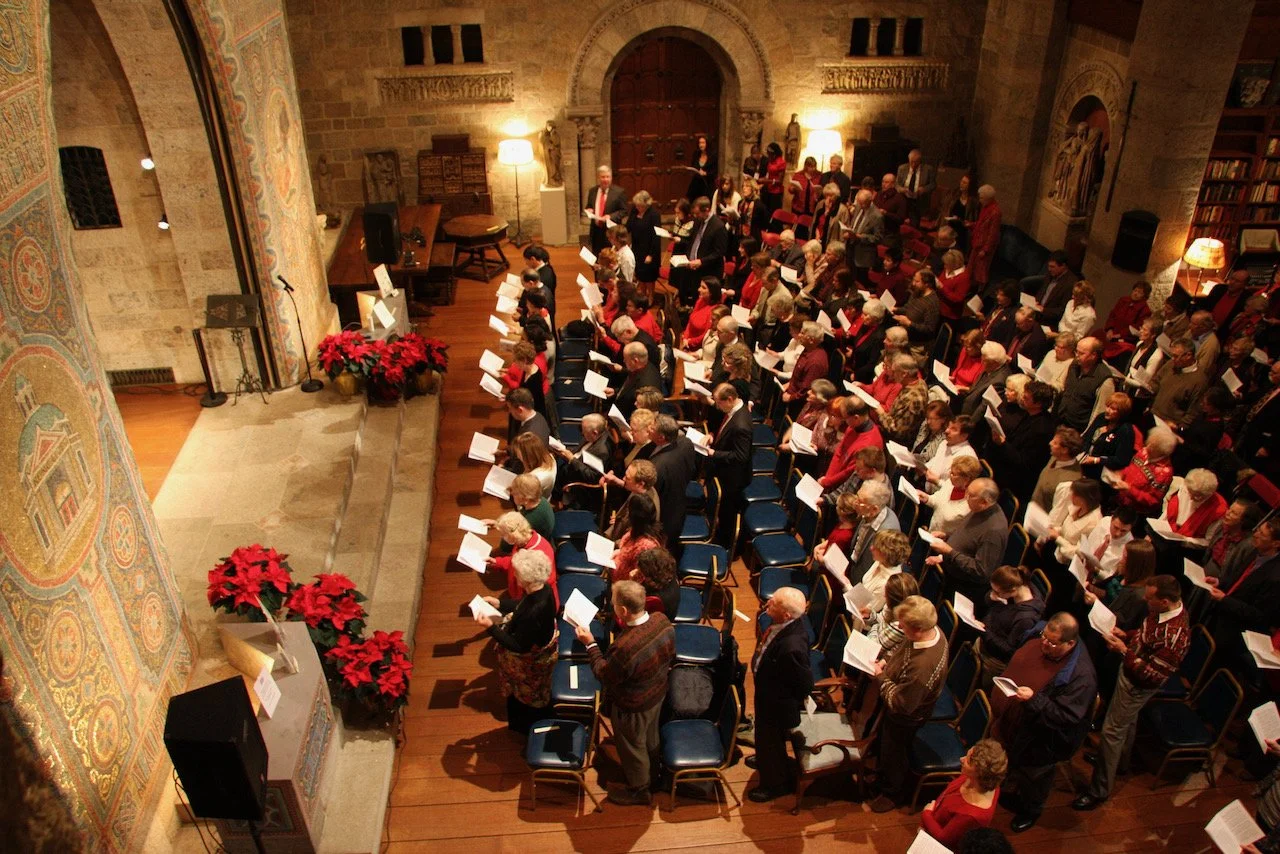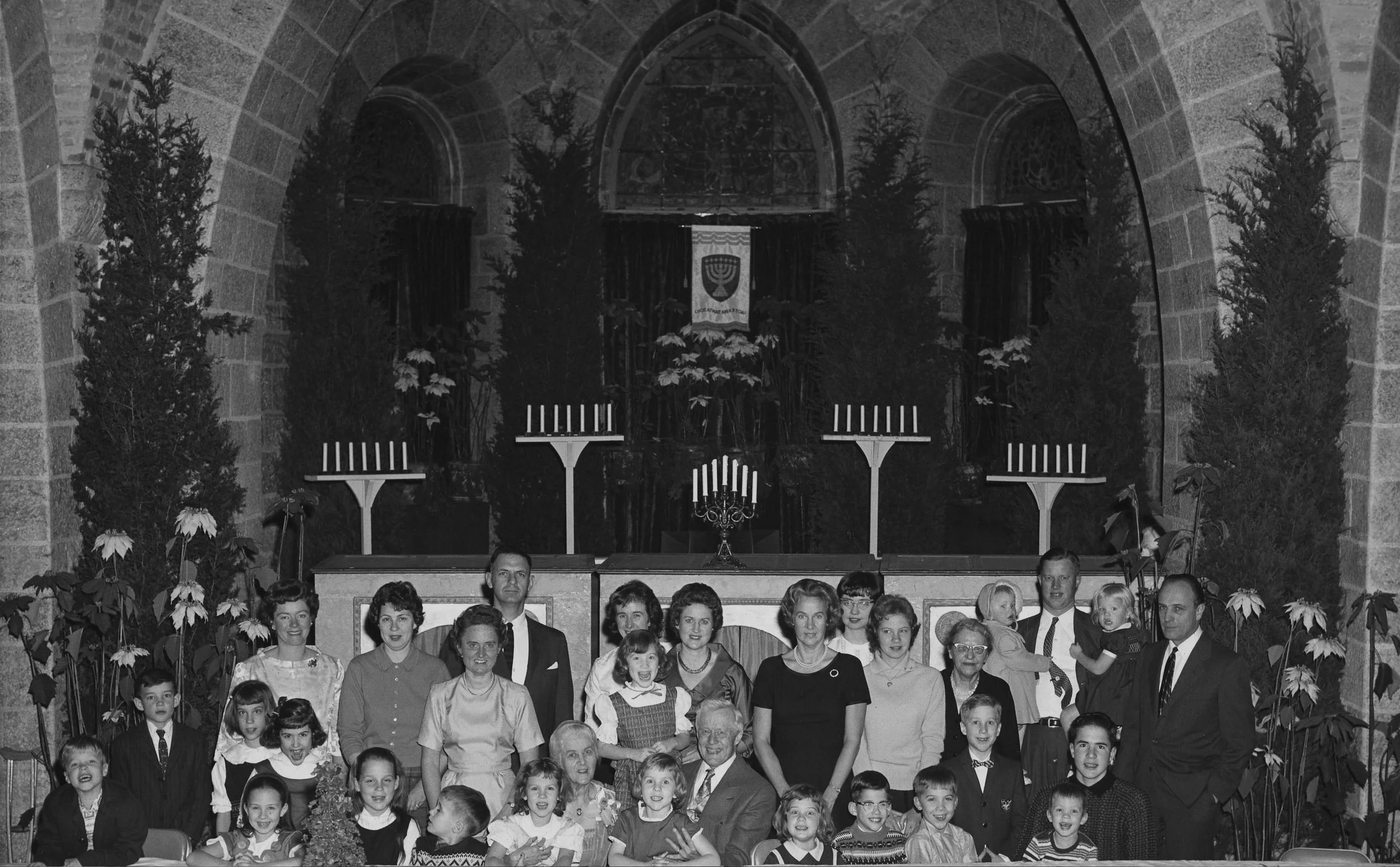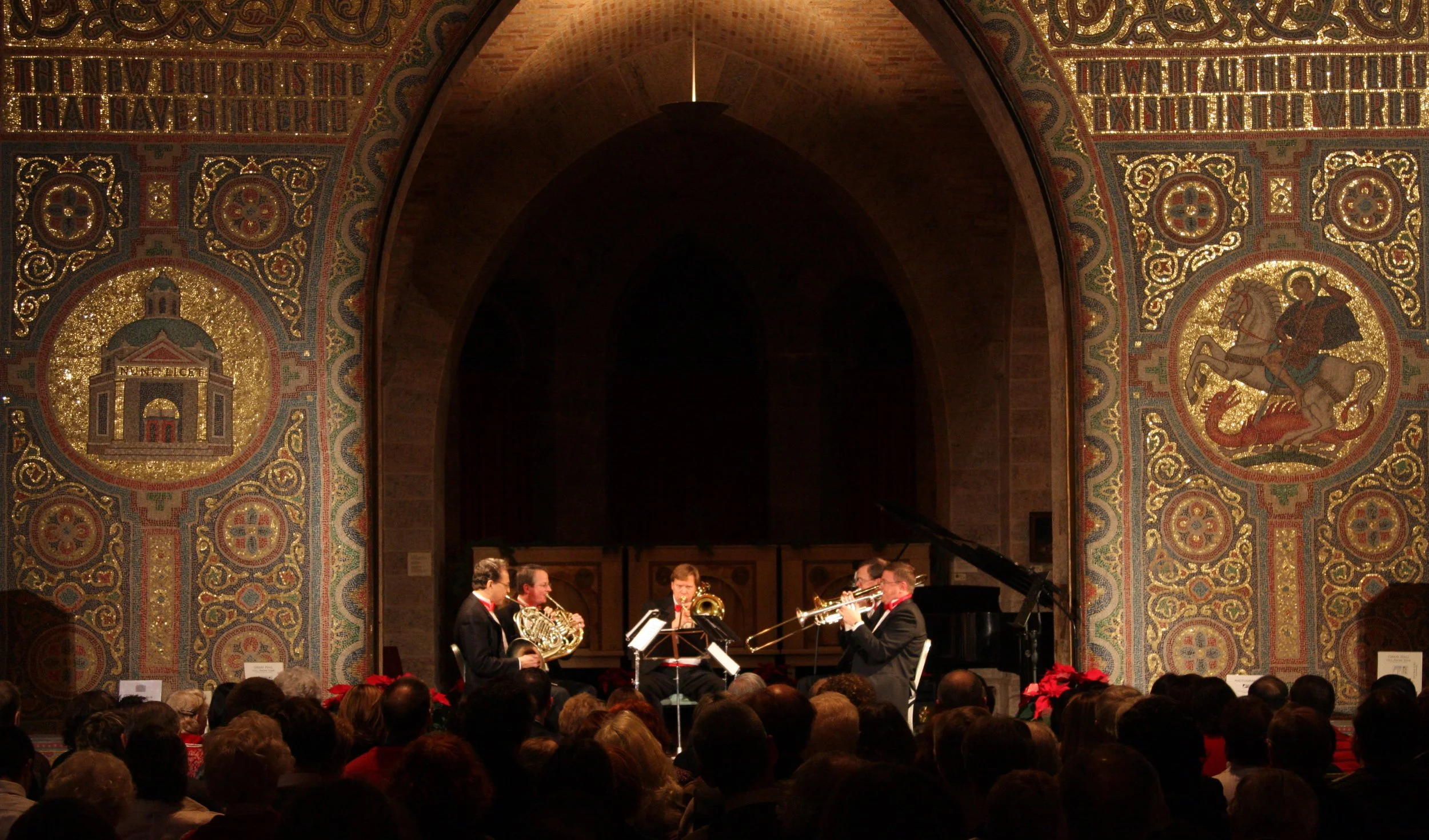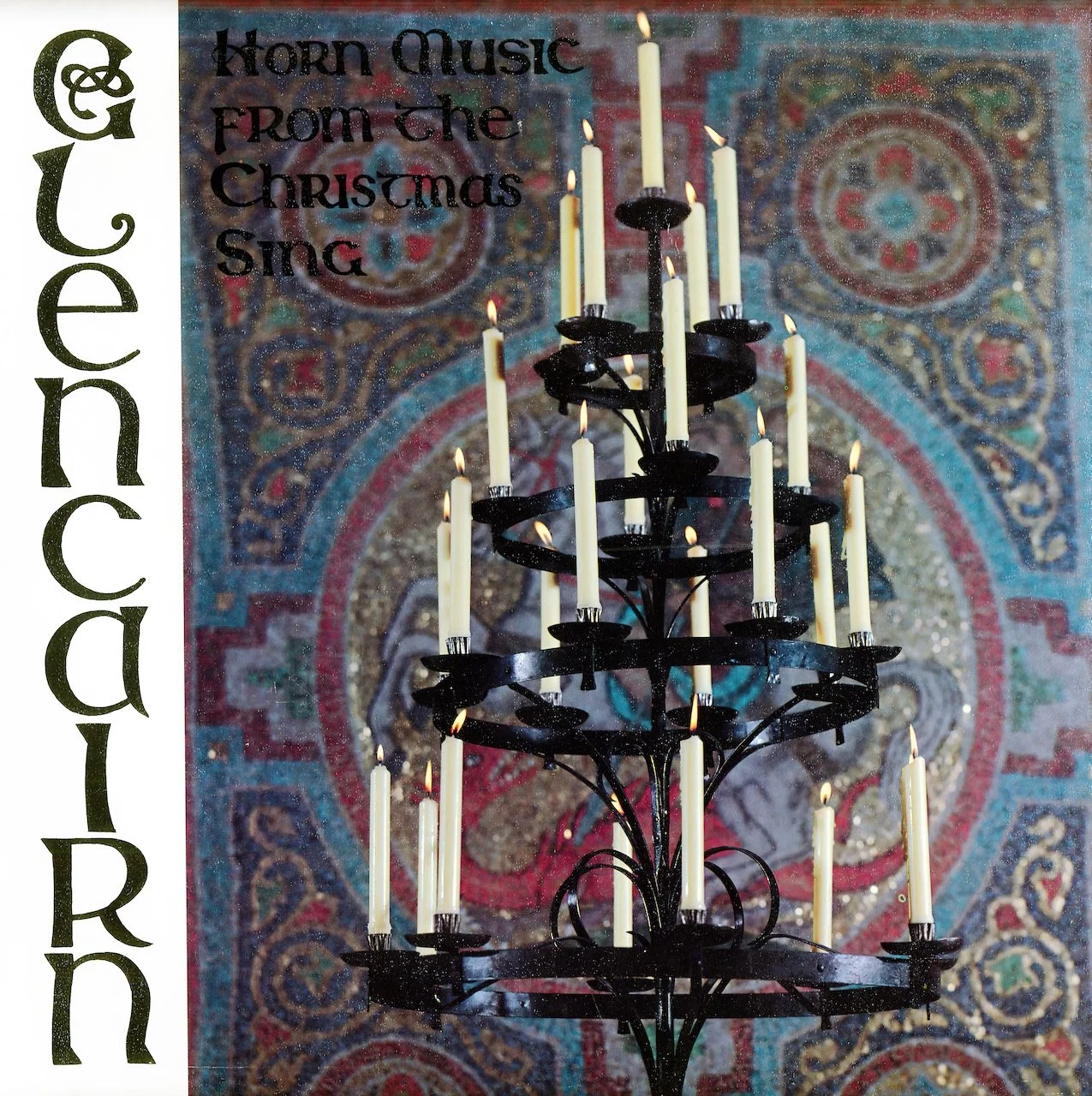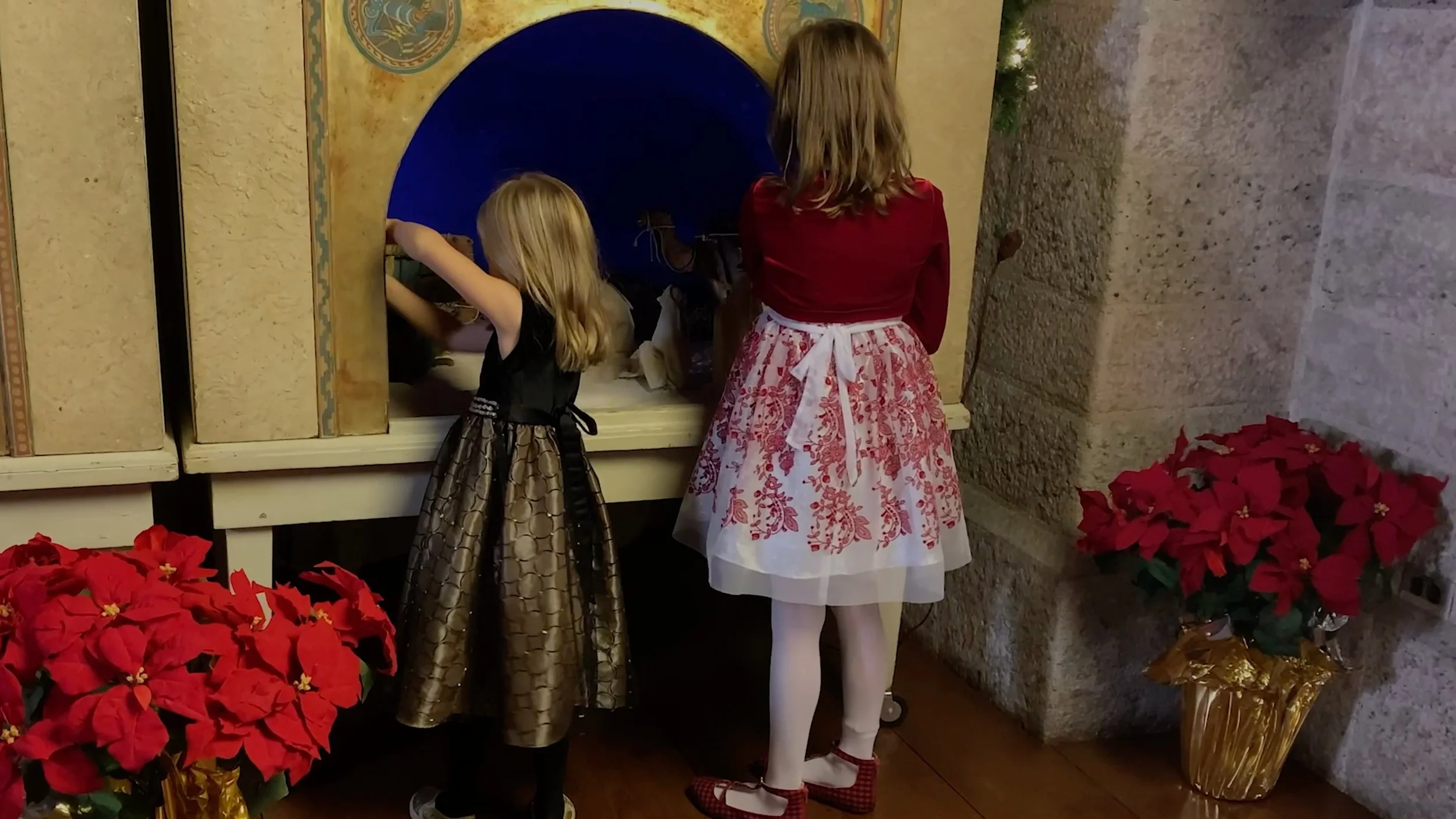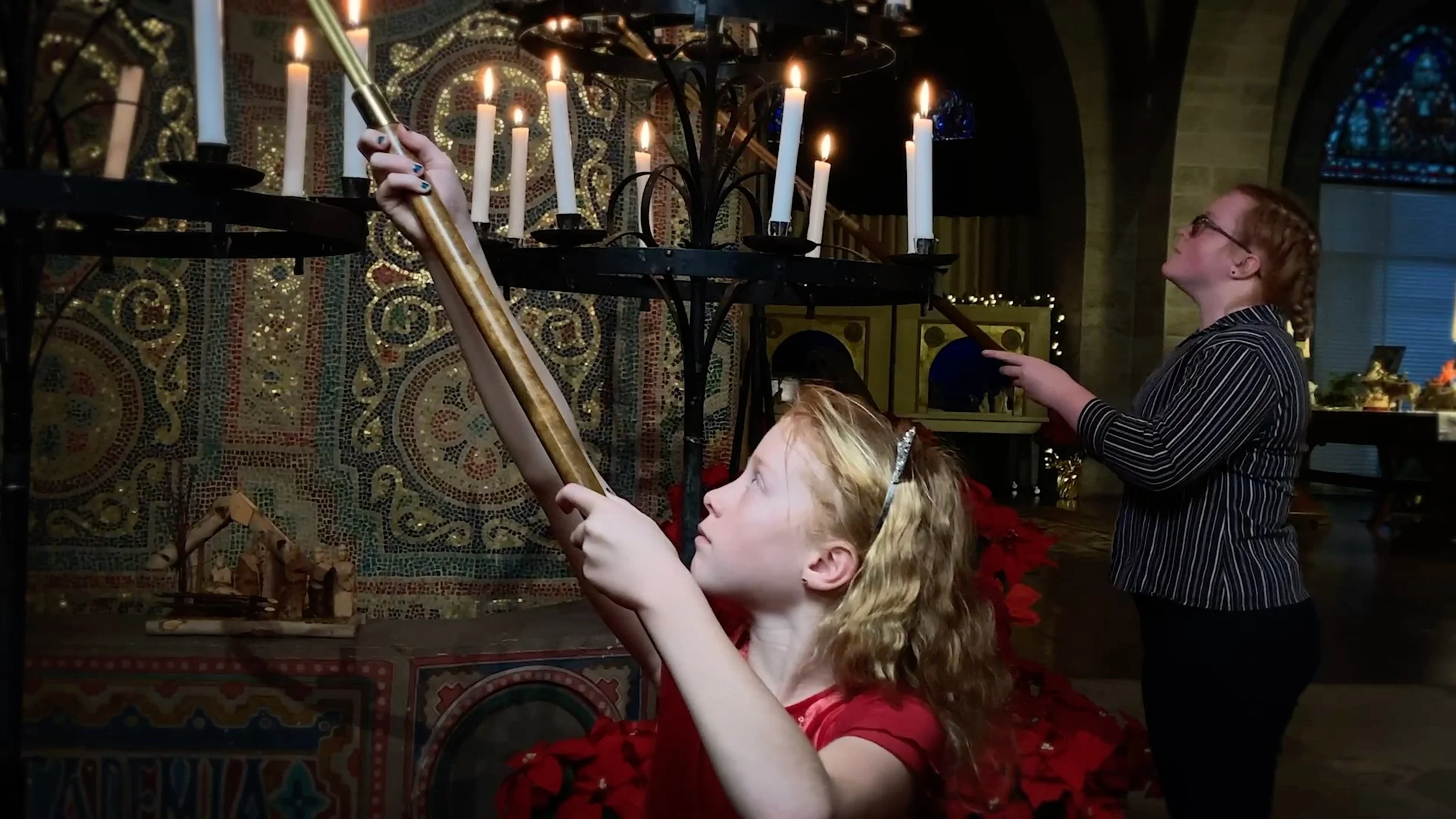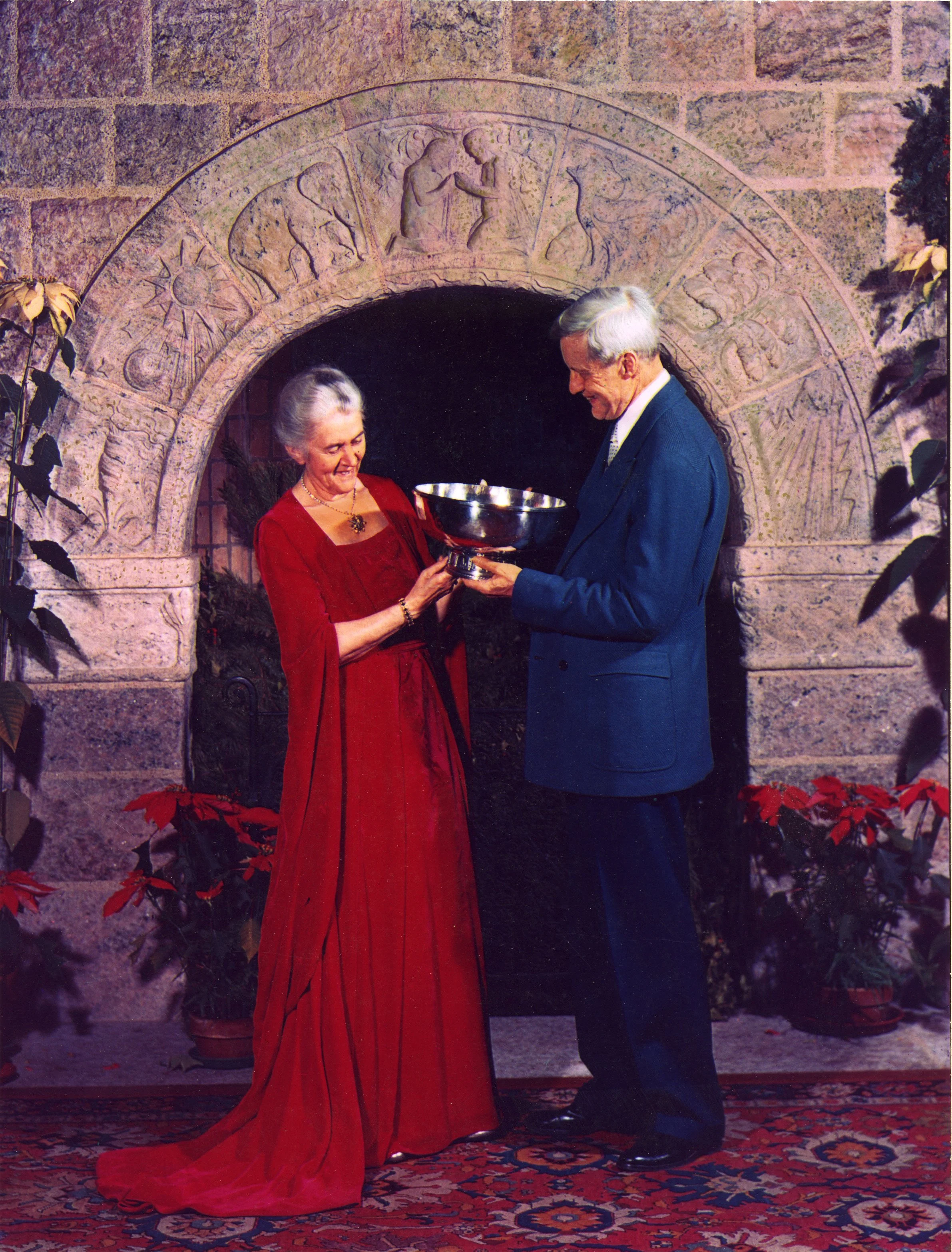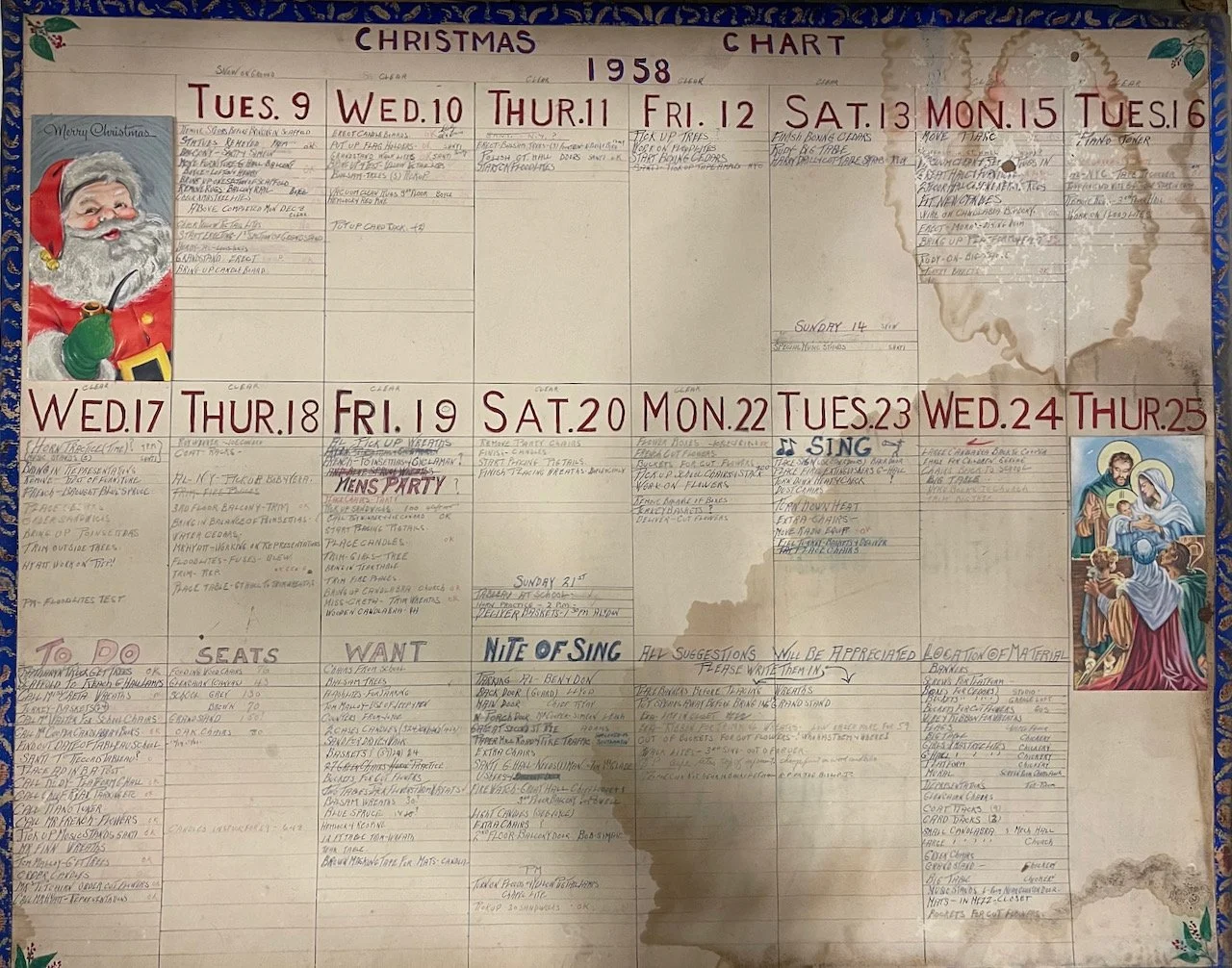Glencairn Museum News | Number 12, 2022
Mildred and Raymond Pitcairn posing with one of the candelabras used for the annual Glencairn Christmas Sing. Mildred is wearing her special red velvet Sing dress. Circa 1950s.
The Glencairn Christmas Sing began in 1937 when Raymond and Mildred Pitcairn offered their home, which was still under construction, as the venue for a Bryn Athyn Orchestra Christmas concert. The concert was very successful, and the Pitcairns began hosting a Christmas concert at Glencairn annually. Glencairn Museum opened to the public in 1982 and has continued this Pitcairn family tradition.
Figure 1: The audience attending the 2008 Glencairn Christmas Sing, seen from the second-floor balcony.
In November of 1937, the Bryn Athyn Orchestra announced in the Bryn Athyn Post, a weekly community newsletter, that a Christmas concert was being planned for December. Two weeks later the newsletter gave the following details:
Figure 2: Entry in the Bryn Athyn Post, vol. 18, no. 48, 1937.
“The Christmas Concert of the Bryn Athyn Orchestra has been postponed to December 19th, at 8:00 p.m. sharp. At Mr. and Mrs. Raymond Pitcairn’s kind invitation, we expect to give this concert in their new home Glenncairn [sic], although construction delays may prevent this, so watch ‘The Post’ for later announcements. The Choir and the Whittington Chorus will take part in the concert, and it is hoped that the audience will join in singing some of the numbers” (Bryn Athyn Post, vol. 18, no. 48, 1937; see Figure 2).
Updates on the concert arrived in each week’s issue of the Post:
“The Bryn Athyn Society, the pupils of the Bryn Athyn School, and the students of the Academy are invited to a Christmas concert at Glenncairn [sic] . . .” (Bryn Athyn Post, vol. 18, no. 50, 1937).
The wording of that first invitation was soon refined in the years that followed: “Mr. and Mrs. Raymond Pitcairn cordially invite the Bryn Athyn Society, the pupils of the Bryn Athyn School, and the students of the Academy to Glencairn for Society Singing and special Christmas music . . .” (Bryn Athyn Post, vol. 20, no. 50, 1939).
The reference to “construction delays” in 1937 was not simply a colorful phrase. The family would not formally move into their new home until the beginning of 1939. According to the Pitcairns’ nephew, E. Bruce Glenn, the “ceiling of the [great] hall and parts of the walls were unfinished, and the teakwood floor had not been laid; but plywood was put down, five hundred chairs were set up, and at the concert every seat was filled” (E. Bruce Glenn, Glencairn: The Building of a Home, 1990, p. 145).
A detailed description of that first concert was published in the Post the following week:
“The Christmas concert at Glencairn on Sunday evening, December 19th, was a delightful occasion from every standpoint, and seemed to be attended by everyone in Bryn Athyn who could arrange to be there. We understand that approximately 500 chairs had been assembled for the occasion, and late comers were hard pressed to find seats.
Cedar trees, pine branches, and, literally, hundreds of candles well befitted the noble dignity of the great hall which lent itself most admirably to the demands of a varied and excellently performed program. In addition to quite a number of ensemble selections, there were notable contributions by a clarinet quartet, a brass sextet, the chorus a capella, and two violin solos by Mr. Raymond Pitcairn, during the playing of which latter the candles were quietly lighted and the electric lights turned out.
Figure 3: This photograph of the Christmas tree in Glencairn’s Great Hall, taken in the 1950s, provides a glimpse of the candles on the balcony railing that were lit during the Sing.
Figure 4: This Pitcairn family photograph from the 1960s, taken in the Upper Hall, demonstrates how the Pitcairns decorated with live greens, trees, and poinsettia plants for the Christmas season and the Sing. The casework for the family’s large, three-part Nativity can be seen behind them. The opening of the curtains to reveal three dioramas illustrating the Nativity story became an important part of the Sing event.
During the intermission, Mr. Pitcairn spoke of the delight which it gave him and Mrs. Pitcairn to be able to have the first use of their new home associated with the peace and happiness of Christmas time, and extended a most gracious welcome to us all . . . As the visitors left, flood lights from within illuminated the stained glass windows, so that the beauty of their coloring could be seen from the outside” (Bryn Athyn Post, vol. 18, no. 51, 1937).
The key features of the event were established in the very earliest years. Hundreds of chairs were set up in the Great Hall facing the large archway leading to the Upper Hall; the space was decorated with evergreens, poinsettias, and candles; the musical program was a varied one with both choral and instrumental pieces, as well as the community singing of hymns; and the performers included all age groups. Raymond Pitcairn, during his lifetime, gave an address of welcome, and the pastor of the Bryn Athyn Church was invited to give a Christmas message. At a certain point in the program, the candles would be lit and the lights dimmed. The only regular element that was not present for the first two years of the Sing was the addition of the “Glencairn Horns,” a group of brass musicians from the Philadelphia Orchestra (Figure 5).
Figure 5: The Glencairn Horns performing in 2008.
Although the Glencairn Horns first joined the Sing in 1939, their association with Bryn Athyn went back much further. Raymond Pitcairn was an amateur musician and the patron of many aspiring young musicians. He was also friends with Leopold Stokowski, the noted conductor of the Philadelphia Orchestra. In 1919, Pitcairn asked Anton Horner, the orchestra’s first horn player, to arrange for a brass quintet to play at the dedication of Bryn Athyn Cathedral. A contemporary description of the event seems to indicate that they played on the west porch of the Cathedral just before the main procession:
“Indeed, the very summons to this Dedication Service was made, not through the means of the customary chimes, but by a concourse of wind instruments on the west porch of the Church. And it was at the climactic instant when their music ceased that the long processional of choir, priests, and laymen—robed in beautiful garments—advanced slowly up the central aisle” (New Church Life, 1919, p. 748).
The horns continued to play annually at the Cathedral on the anniversary of its dedication and at Christmas. The Cathedral’s curator, William R. Cooper, related an amusing incident involving Stokowski that took place during one of their rehearsal sessions in the 1930s. Stokowski had come for a visit, and upon hearing the rehearsal, “he commented on the fine quality of our horns. He was surprised to learn that the players were members of his own orchestra!” (New Church Life, 1933, p. 332).
Figure 6: Album cover for the LP made during a 1979 rehearsal of the Glencairn Horns.
Members of the Pitcairn family often played with the Glencairn Horns during the Christmas Sing. Nathan and Garth Pitcairn both played French horn, and Lachlan Pitcairn played the trombone. Lachlan arranged for a recording and LP record to be made during a rehearsal in 1979 (Figure 6). The liner notes provide some background to the Pitcairn brothers’ involvement:
“Horner . . . taught French horn to Nathan Pitcairn, and later to Garth Pitcairn, who played with the group for many years. This tradition is continued by their brother Lachlan, who plays trombone on this album [since 1946]. As true amateurs, they joined the professionals from the Orchestra, performing from a love of music and the use to which it contributes” (E. Bruce Glenn, Glencairn: The Building of a Home, 1990, p. 150).
The liner notes also describe the role of the Horns in the candle lighting portion of the evening: “From an unseen balcony the horns play, while in the dimmed hall hundreds of candles are lighted in great candelabra and along the railing of the gallery.”
It is not known exactly how the “candles were quietly lighted” that first year in 1937. However, a pattern was eventually established where daughters, nieces, and later granddaughters became part of the tradition (Figure 9). The lighting ceremony had two components. While older girls lit the hundreds of candles on the candelabras and balcony railing, younger children would open the curtains on the family’s large, three-part Nativity (Figures 7–8). Lynn Pitcairn Genzlinger, one of Raymond and Mildred’s granddaughters, has shared memories of her participation in these portions of the program. First, as a young child, she participated in the opening of the Nativity curtains during a particularly memorable year:
Figure 7: A recent photograph of the Pitcairn family Nativity shows its placement in the apse of the Upper Hall. The curtains have already been opened. Each scene has curtains on both sides that meet in the middle.
“I got to do that when I was seven and had a broken leg. I hobbled out with two other injured cousins (I think one had an arm in a sling and I can’t recall what had happened to the other cousin. It must have been quite a sight.) Since my toes were exposed in a cast that ran from the base of my toes to the top of my thigh, Mom put my knitted Christmas stocking over my cast to keep my toes warm. As I hobbled out on my crutches, the little bells on the stocking tinkled away, making me feel very conspicuous. This all happened while the lights were low and it was otherwise very quiet” (Email communication. Lynn Pitcairn Genzlinger to Kirsten H. Gyllenhaal, 4/2/2018).
Figure 8: Two descendants of Raymond and Mildred Pitcairn recreate the opening of the Nativity curtains.
When Lynn was older, she participated in the candle lighting, which always involved Mildred Pitcairn:
“We would gather in the entry hall where Joyce [Bellinger] handed out the poles. She gave the lead granddaughter a lit candle that she carried out to Grandma, sitting in the Great Hall, a few rows back from the front and on the edge of a center aisle. That granddaughter would then light her taper from the candle, with each of the cousins following suit. That brings back such good memories . . . We felt very special when asked to do these Christmas jobs” (Email communication. Lynn Pitcairn Genzlinger to Kirsten H. Gyllenhaal, 4/2/2018).
Figure 9: Two descendants of Raymond and Mildred Pitcairn recreate the lighting of the candelabras.
A red velvet gown designed for Mildred became her exclusive Christmas Sing outfit (Figure 10). Now in the Glencairn Museum collection, it is exhibited annually in the main bedroom as a stop during the Christmas in the Castle tour. A close look at the hem of the gown reveals a few drips of wax—perhaps the result of many years of Christmas Sing candle lighting.
Figure 10: In 1951 Raymond and Mildred received a silver bowl as a Christmas gift from the Bryn Athyn congregation. It was presented to them at the Sing. In this photograph the Pitcairns pose with the bowl in front of the fireplace in the Upper Hall. Mildred is wearing her red velvet Sing gown.
In Bryn Athyn, the month of December can sometimes produce a wintry mix, and occasionally a snowstorm, but the popularity of the Christmas Sing has ensured good attendance regardless of the weather. Of 500 seats available for the 1946 concert, “over 450 were taken in spite of heavy rain, sleet, and snow. The room was beautiful and beautifully decorated with large poinsettia plants and rows of lighted candles, especially on the balcony” (Bryn Athyn Post, vol. 27, no. 52, 1946).
The yearly preparation for the Sing was an undertaking of considerable size, requiring the concentrated efforts of many of the Pitcairns’ full- and part-time staff. A large, homemade calendar from the 1950s has a list of tasks for each day leading up to the concert (Figure 11). Calendar pages have survived from a number of different years during that decade, providing information about the process. Examples of notes from 1958: “statues removed from balcony”; “bring up candle board” (used on balcony railing to hold candles); “balsam trees (5) pickup”; “polish GT (Great) Hall doors”; and “work on floodlites.”
Figure 11: Homemade calendar for Glencairn in 1958 detailing tasks for every day leading up to the Sing and Christmas.
What began in 1937 as a kind invitation from the Pitcairn family to host the local orchestra concert at Glencairn, became a community tradition that continues to this day. Unfortunately, due to Glencairn Museum being closed to complete a significant infrastructure replacement project, this year’s Glencairn Sing will not be held in person. Instead, it will take place as an online program, available to a worldwide audience. Click here to find out more.
(KHG)
Would you like to receive a notification about new issues of Glencairn Museum News in your email inbox (12 times per year)? If so, click here. A complete archive of past issues of Glencairn Museum News is available online here.


